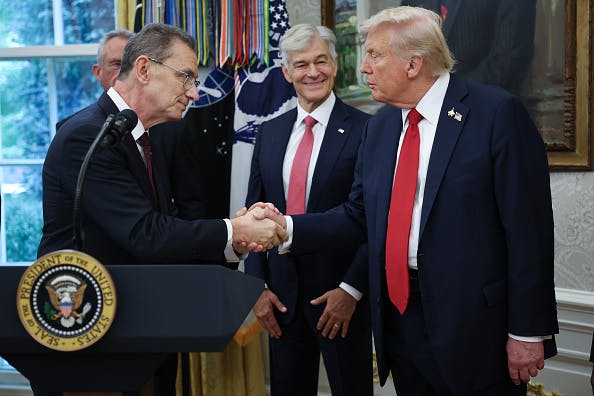Can pharma companies put tariff threats behind them?
Big Pharma may have gotten Trump off its back for now. But are drug prices coming down?
For the past nine months, pharmaceutical companies have been paralyzed by uncertainty over the threat of US tariffs. It appears that regulatory haze is starting to clear.
Pfizer CEO Albert Bourla stood with President Trump on Tuesday and announced that his company had agreed to sell drugs through Medicaid at prices lower than other wealthy countries and to offer cash-pay discounts on some of its drugs. Pfizer shares rallied along with the entire sector as Wall Street took the announcement as a sign that companies could get the administration off their backs without shrinking margins, in part by cutting out middlemen.
Boardrooms are now in a place to take more decisive actions, Stephen Farrelly, the global lead for ING's pharma and healthcare research. “The biggest problems that boardrooms have faced over the past nine months is: what do we do with all of this?”
President Trump has threatened to impose tariffs on pharmaceuticals, which are typically shielded from trade wars, since he took office.
Trump’s tariff threats have taken many forms this year, but most recently, on September 25, he said that starting on October 1, there would be a 100% tariff on patented, branded pharmaceuticals “unless a Company IS BUILDING their Pharmaceutical Manufacturing Plant in America.” A July 31 letter sent to 17 drugmakers asked them to commit to lowering prices by the same deadline.
Most drugmakers have already committed to investing in US manufacturing. And Pfizer “may have done the rest of the industry a favor by giving a framework for a bespoke solution that we feel would be very tenable” for most drugmakers with little impact on their business, analysts at Jefferies wrote in an October 1 note.
“I think we can almost put the tariff conversation to bed,” Farrelly said.
So, are drug prices going to fall?
The Pfizer deal applies only to brand-name drugs, which are typically manufactured in Europe. Generics, which account for more than 90% of prescriptions filled in the US, are predominantly made in China and India by other manufacturers. The Trump administration is still considering tariffs on those, citing national security concerns.
Pfizer also agreed to participate in “TrumpRx,” which is not live yet, but has been described as a website that will point people to direct-to-consumer options from manufacturers — allowing Trump to put his stamp on a trend well underway in the industry.
“You might think of it as an overlay on what was already happening with the DTC prices,” said Miriam Paramore, CEO of RxUtility, a service that helps patients find affordable prescriptions. “Anything that focuses on lowering prescription prices is good. On the other hand, I think it’s going to add confusion for the consumer.”
Novo Nordisk and Eli Lilly were the first drugmakers to wade into DTC sales by offering cash-pay options for their popular weight-loss shots, which are often not covered by insurance. Several other drugmakers have followed suit, offering direct cash-pay options for brand-name drugs.
Let’s say you have a prescription for Lilly’s Zepbound, the hottest weight-loss drug on the market right now. Here are the prices you might pay:
Your insurance, if you have it, will be billed roughly $1,200 for a month’s supply. If they don’t cover it, this is what you would be charged at the pharmacy counter.
If you are covered, the average copay is about $25.
If you are not covered or are not using insurance, you can now buy it online directly from Lilly for between $349 and $499.
So, by adding a DTC option, Lilly is able to say it brought the price of Zepbound down from $1,200 to $349.
Though patients were given a new option, at no point was Lilly required to accept a lower profit margin because it simply cut out middlemen by selling directly to the patient instead of selling to a wholesaler, which sells it to a pharmacy, which bills an insurance company.
“When they bypass that and go directly to consumers, yes, technically the price is being reduced, but the manufacturers are making the same amount of money,” said Alec Ginsberg, owner of C.O. Bigelow, a pharmacy in Manhattan.
Still, many brand-name drugs Americans take aren’t as DTC-friendly as GLP-1s, which are in high demand but generally not immediate life-or-death treatments.
Some drugs, like Merck's Keytruda, have to be administered in a healthcare setting, which makes it difficult to sell directly to a patient. Others are simply so expensive that even large discounts don’t make it worth paying for without insurance.
For example: Xeljanz, a pill for several inflammatory conditions made by Pfizer, will be 40% off for cash-paying patients under the deal announced Tuesday, meaning the roughly $6,000 list price for a month’s supply goes down to $3,600 for those paying cash. That is still, for most people, prohibitively expensive.
“Almost nobody in America pays for brand-name medications out of pocket because costs are astronomical,” Ginsberg said.
So far, the president’s actions on drug pricing have focused on drugmakers. But about half of every dollar spent on medications goes to middlemen, according to an estimate from the pharma lobby.
The biggest chunk of that goes to pharmacy benefit managers, which are used by insurance companies to get better deals on medications. PBMs can push up drug prices by demanding manufacturer rebates for covering a medication, marking up drugs through spread pricing, and steering patients toward higher-cost medications.
“All these manufacturer websites are workarounds,” Douglas Hoey, CEO of the National Community Pharmacists Association, said in an October 1 statement. “Reforming the way PBMs and insurance companies operate is the only solution.”
